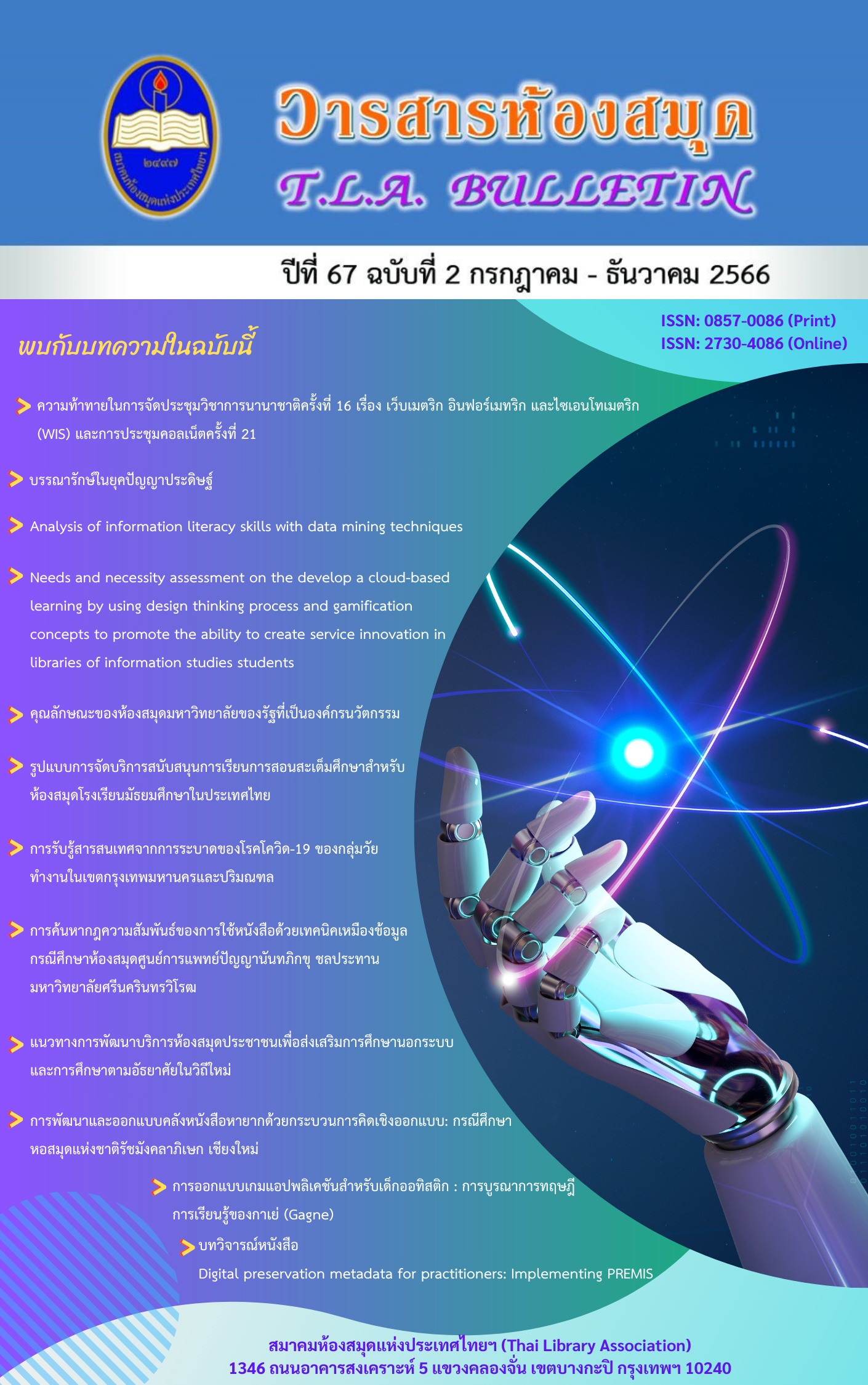รูปแบบการจัดบริการสนับสนุนการเรียนการสอนสะเต็มศึกษาสำหรับห้องสมุดโรงเรียนมัธยมศึกษาในประเทศไทย
คำสำคัญ:
บริการห้องสมุด, สะเต็มศึกษา, ห้องสมุดโรงเรียนบทคัดย่อ
บทความวิจัยนี้มีวัตถุประสงค์เพื่อศึกษาสภาพ ปัญหา ความต้องการและปัจจัยที่สนับสนุนการจัดบริการ พัฒนารูปแบบการจัดบริการ ตรวจสอบและยืนยันรูปแบบการจัดบริการสนับสนุนการเรียนการสอนสะเต็มศึกษาสำหรับห้องสมุดโรงเรียนมัธยมศึกษาในประเทศไทย การวิจัยแบ่งเป็น 3 ระยะ คือ ระยะที่ 1 การวิจัยเชิงสำรวจ กลุ่มตัวอย่างคือครูบรรณารักษ์ 330 คน เก็บข้อมูลโดยใช้แบบสอบถาม วิเคราะห์ข้อมูลโดยคำนวณความถี่ ร้อยละ ค่าเฉลี่ยและส่วนเบี่ยงเบนมาตรฐาน ระยะที่ 2 การวิจัยเชิงคุณภาพ ใช้เทคนิคการสนทนากลุ่มประกอบด้วยผู้เชี่ยวชาญ 8 คน วิเคราะห์ข้อมูลโดยสรุปและจัดกลุ่มข้อมูลตามประเด็น ระยะที่ 3 การวิจัยอ้างอิงผู้ทรงคุณวุฒิ 10 คน วิเคราะห์ข้อมูลโดยสรุปข้อมูล ผลการวิจัยพบว่า (1) ครูบรรณารักษ์ส่วนใหญ่มีวัตถุประสงค์ของ การจัดบริการเพื่อรวบรวมและจัดเก็บทรัพยากรสารสนเทศสะเต็มไว้ให้บริการ ทรัพยากรสารสนเทศส่วนใหญ่ที่จัดให้บริการ ได้แก่ หนังสือชุดวิทยาศาสตร์ หนังสือการ์ตูนวิทยาศาสตร์ และหนังสือสารคดีวิทยาศาสตร์ ครูบรรณารักษ์ส่วนใหญ่จัดบริการทรัพยากรสารสนเทศสำหรับสะเต็มศึกษาและบริการสารสนเทศสะเต็มสำหรับสื่อและอุปกรณ์ส่วนใหญ่ที่จัดให้บริการ ได้แก่ อินเทอร์เน็ตและคอมพิวเตอร์ ครูบรรณารักษ์ส่วนใหญ่ได้รับความร่วมมือหรือความช่วยเหลือจากครูผู้สอนสะเต็มศึกษาภายในโรงเรียน ผู้บริหารโรงเรียน และศึกษานิเทศก์ ครูบรรณารักษ์ประสบปัญหาการจัดบริการโดยรวมในระดับปานกลาง ปัญหาที่ประสบมากที่สุด คือ ด้านการสนับสนุนของผู้บริหาร ครูบรรณารักษ์ต้องการการจัดบริการโดยรวมในระดับมาก บริการที่ต้องการจัดบริการมากที่สุด คือ บริการทรัพยากรสารสนเทศสำหรับสะเต็มศึกษา (2) ปัจจัยที่สนับสนุนการจัดบริการมีผลต่อความสำเร็จในการจัดบริการโดยรวมในระดับมาก ปัจจัยที่สนับสนุนการจัดบริการมากที่สุด คือ ด้านการจัดการเรียนรู้ (3) รูปแบบการจัดบริการสนับสนุนการเรียนการสอนสะเต็มศึกษาสำหรับห้องสมุดโรงเรียนมัธยมศึกษาในประเทศไทย มี 10 องค์ประกอบ ได้แก่ นโยบายและบริบท นักเรียน ครูผู้สอนสะเต็มศึกษา ผู้บริหารและศึกษานิเทศก์ ครูบรรณารักษ์ บริการ พื้นที่ สิ่งสนับสนุน สื่อ และการเรียนรู้สะเต็ม และ (4) ผู้ทรงคุณวุฒิทุกคนเห็นว่ารูปแบบการจัดบริการสนับสนุนการเรียนการสอนสะเต็มศึกษาสำหรับห้องสมุดโรงเรียนมัธยมศึกษาในประเทศไทยโดยรวมมีความเหมาะสม
Downloads
เอกสารอ้างอิง
Cohen, S., Poitras, I., Mickens, K., & Shirali, A. (2018). Roles of the school librarian: Empowering student learning and success. Retrieved March 1, 2021, from http://www.nysl.nysed.gov/libdev/slssap/ncc-roles-brief.pdf
Duff, M. L. (2012). 10 steps to creating a cutting-edge STEM school library. Young Adult Library Services, 10(2), 24-28.
Institute for the Promotion of Teaching Science and Technology (IPST). (2014). STEM education. Bangkok: IPST. [In Thai]
Johnston, M. P. (2017). Best IASL conference 2017 paper: Preparing teacher librarians to support STEM education. In L. Farmer (Ed.), Learning without borders. International Association of School Librarianship Conference 2017 Proceedings (pp.3-13). University of Alberta Libraries. https://doi.org/10.29173/iasl7145
Johnston, M. P. (2018). Supporting STEM education: Needs assessment of southeastern rural teacher librarians. School Libraries Worldwide, 24(2), 62-79. https://doi.org/10.29173/slw8229
Johnston, M. P. (2019). Empowering teacher librarians to support STEM education: Preliminary findings. Retrieved December 1, 2022, from https://journals.library.ualberta.ca/slw/index.php/iasl/article/view/7432
Krejcie, R. V., & Morgan, D. W. (1970). Determining sample size for research activities. Journal of Educational and Psychological Measurement, 30(3), 607-610. https://doi.org/10.1177/001316447003000308
Latham, D., Julien, H., Gross, M., & Witte, S. (2016). The role of inter-professional collaboration to support science learning: An exploratory study of the perceptions and experiences of science teachers, public librarians, and school librarians. Library & Information Science Research, 38(3), 193-201. https://doi.org/10.1016/j.lisr.2016.08.002
Liamsang, R., & Chatruprachewin, C. (2018). Administrational strategies for STEM education of secondary school under the Office of the Basic Education Commission. Silpakorn Education Research Journal, 10(2), 379-393. [In Thai]
Mardis, M. A. (2014). Ready for STEM?: A leading commercial multimedia database as a source for media-rich science, technology, engineering, and mathematics assets for K-12 library collections. Library Resources & Technical Services, 58(4), 250-264.
Mardis, M., McLaughlin, C., & Gingell, G. (2012). Web2MARC: Sharing and using STEM digital content in school libraries. In K. Boughida, et al. (Eds.), Proceedings of the 12th ACM/IEEE-CS joint conference on digital libraries (pp.407-408). Association for Computing Machinery. https://doi.org/10.1145/2232817.2232914
National STEM Education Center (NSEC). (2014). Handbook for STEM teacher training course. Retrieved March 1, 2021, from http://www.stemedthailand.org/wp-content/uploads/2015/03/newIntro-to-STEM.pdf.pdf [In Thai]
Office of the Basic Education Commission (OBEC). (2021). Education Management Information System (EMIS). Retrieved March 1, 2021, from https://data.bopp-obec.info/emis [In Thai]
Office of the Education Council (OEC). (2007). Problem-based learning. Bangkok: OEC. [In Thai]
Office of the Education Council (OEC). (2020). Monitoring and evaluation of STEM knowledge integration in educational institutions. Bangkok: OEC. [In Thai]
Office of the National Economic and Social Development Board. (2016). The 12th national economic and social development plans. Retrieved March 1, 2021, from https://www.nesdc.go.th/ewt_dl_link.php?nid=6422 [In Thai]
Rogowski, A., Recker, M., Lee, V. R., Searle, K. (2020). Librarians as informal learning designers: A framework for facilitating STEM-rich making in the school library. Retrieved December 1, 2022, from https://digitalcommons.usu.edu/researchweek/ResearchWeek2020/All2020/43/
Subramaniam, M., Ahn, J., Waugh, A., Taylor, N G., Druin, A., Fleischmann, K. R., & Walsh, G. (2013). The role of school librarians in enhancing science learning. Journal of Librarianship and Information Science, 47(1), 1-14. https://doi.org/10.1177/0961000613493920
Subramaniam, M. M., Ahn, J., Fleischmann, K. R., & Druin, A. (2012). Reimagining the role of school libraries in STEM education: Creating hybrid spaces exploration. Library Quarterly, 82(2), 161-182. https://doi.org/10.1086/664578
Woods, S., & Hsu, Y. C. (2020). Making spaces for STEM in the school library. TechTrends, 64, 388-394. https://doi.org/10.1007/s11528-019-00460-9
Young, T. E., Jr. (2012). STEM: Sparking innovation and imagination in school libraries. Library Media Connection, 30(5), 14-16. https://doi.org/10.1007/s11528-019-00460-9
ดาวน์โหลด
เผยแพร่แล้ว
รูปแบบการอ้างอิง
ฉบับ
ประเภทบทความ
สัญญาอนุญาต
ลิขสิทธิ์ (c) 2023 วารสารห้องสมุด สมาคมห้องสมุดแห่งประเทศไทยฯ

อนุญาตภายใต้เงื่อนไข Creative Commons Attribution-NonCommercial-NoDerivatives 4.0 International License.




